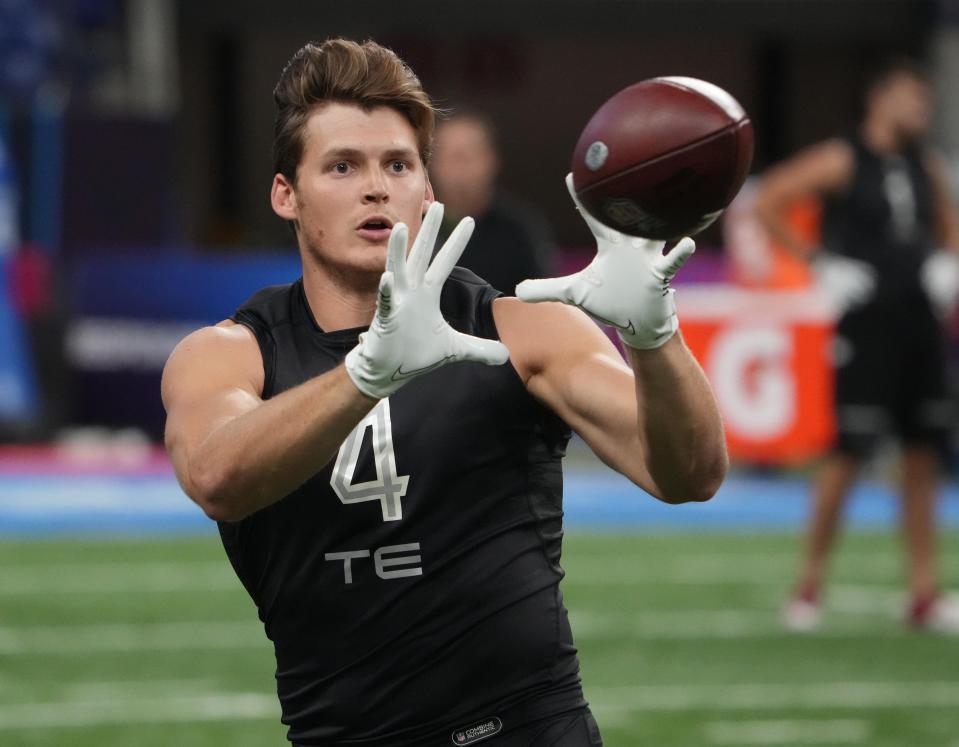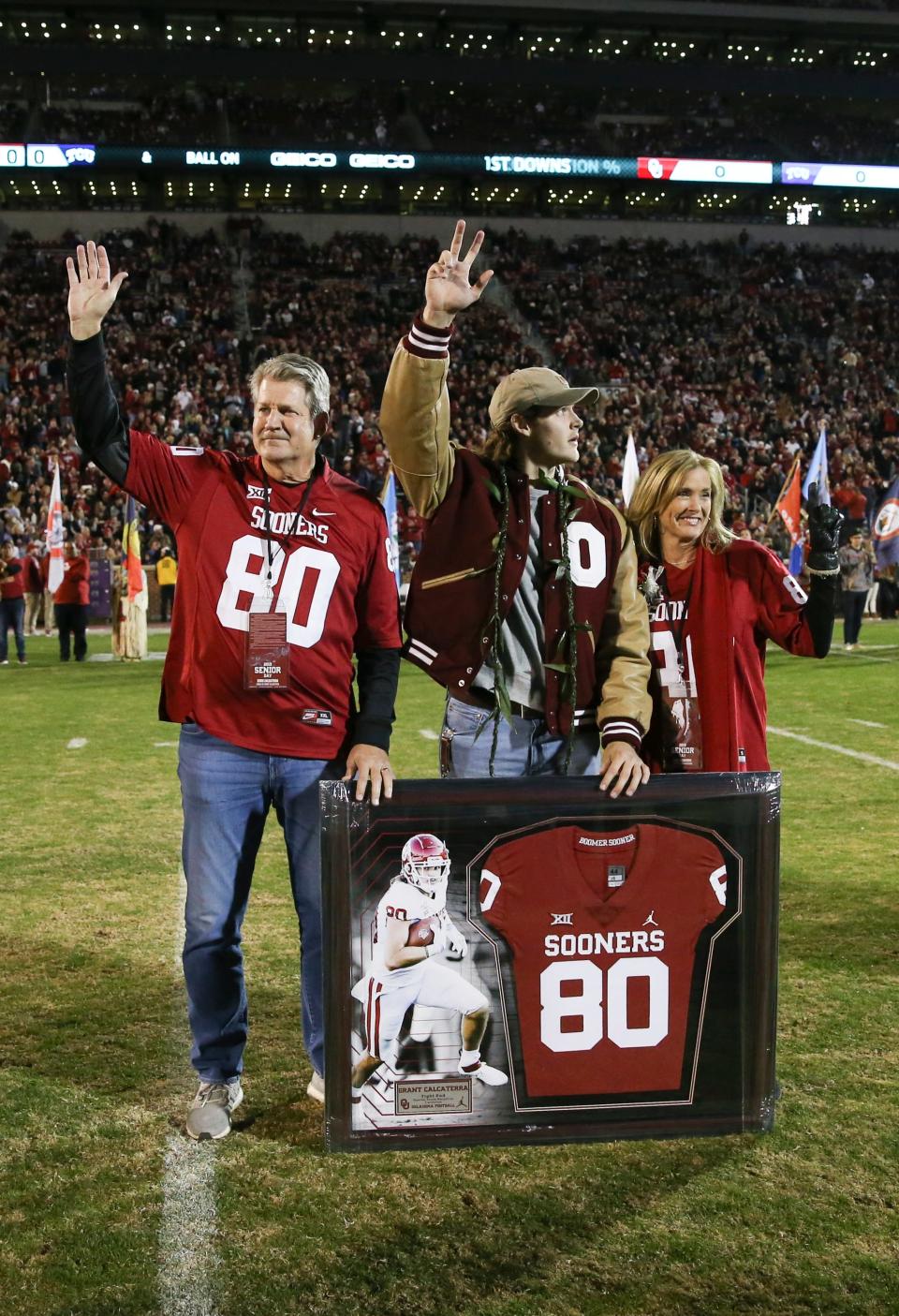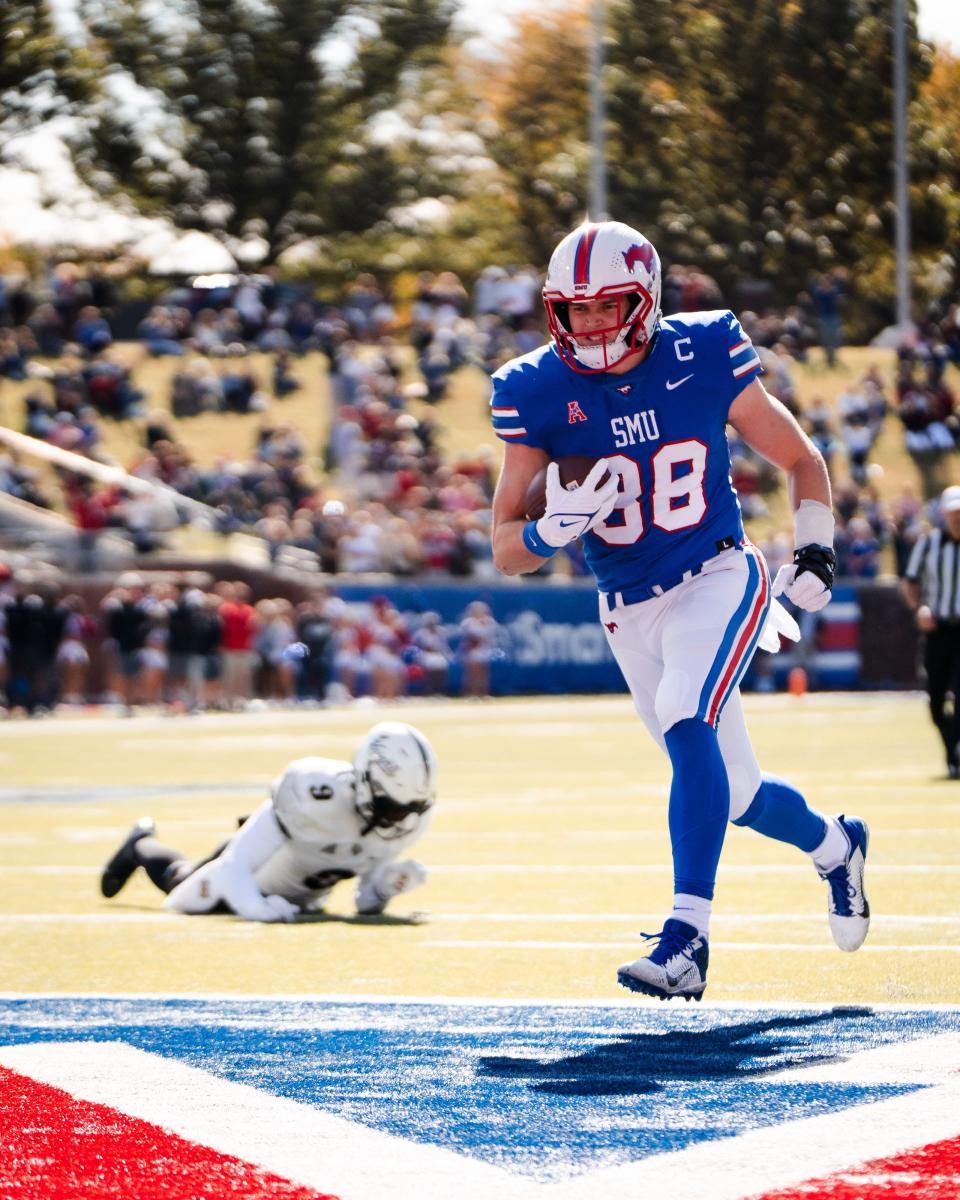Grant Calcaterra quit football after three concussions. Now, he's on verge of achieving NFL dream.
DALLAS — The urge first returned when Grant Calcaterra watched the 2020 NFL draft.
“Man, I’m better than some of these dudes,” he told himself as he watched the draft class he had once expected to join. “I’m just as good as some of these guys getting drafted.”
The former first-team All-Big 12 Oklahoma tight end began to think more about the dream he’d prematurely split from, the retirement he had announced in November 2019 after what he says were three diagnosed concussions in a calendar year.
“I just kind of prided myself on a great college career and said, ‘I’d rather be safe,’” Calcaterra told USA TODAY Sports. “I want to live a long time and do a lot of different things.”
In “retirement,” Calcaterra had done just that, seeking neither rest nor freedom from responsibility. If football wasn’t meant to be, he decided, he would instead direct what former Oklahoma quarterback Baker Mayfield described as the “dog in him” toward another yearslong dream: firefighting.
In nine months, he completed his communications degree from Oklahoma; applied to work for the Los Angeles Fire Department; completed EMT training and passed his registry licensing test; labored for a construction company at a school construction site; and worked toward what soon became a job offer as an EMT professional for a private ambulance company.
But come July 2020, he still missed the game. No major epiphany nor health change arrived, he says, so much as months of contemplation building toward the conclusion: “Let’s do it.”
He told his father, Chris, in their garage gym that month.
“My initial reaction was not positive, I can assure you that,” Chris Calcaterra said. “I’ll always be concerned. But I finally got to a place where, if I was 23 years old and had his talent and could do this, what would I do? I’d probably give it one more shot.”
Now a Class of 2022 NFL draft prospect, Grant is.
NFL MOCK DRAFT: Projecting more trades that could create first-round chaos

‘Are you kidding me?’
Grant Calcaterra forgives you if you’re thinking: Is he crazy?
“Crazy that I stopped playing football right before I was going to be a top pick,” he said, “and then it’s also crazy to come back.
“Like, ‘Are you kidding me, dude? You’re an idiot.’”
But family, friends, coaches and teammates offer another perspective: They see a draft prospect so committed to greatness that he never stopped chasing it, he merely temporarily redirected the chase when he thought he had no choice.
Before medical questions loomed, Calcaterra had prospered in college football.
As a true freshman at Oklahoma in 2017, he established such rapid chemistry with Mayfield that he snagged the Sooners’ first touchdown of the season — on an audible in which Mayfield trusted him to exploit single coverage. Calcaterra’s understanding of and role in the offense outpaced expectations with guidance from Mayfield and tight end Mark Andrews, in Andrews’ final collegiate season before the Ravens drafted the 2021 All-Pro. The upperclassmen liked Calcaterra’s hunger and enthusiasm.
“Great frame, long arms and his ability to high-point the ball and catch it with his hands, that’s just a God-given talent he has,” Mayfield told USA TODAY Sports by phone. “He’s this guy who comes out of Southern California, has got the luscious locks, kind of looks like Sunshine from 'Remember the Titans.' (But) he’s a tough dude.
“When he steps on the field, it’s not that laidback, Southern California lifestyle.”
Calcaterra earned All-Big 12 honorable mention honors as a freshman for his 10-catch, 162-yard, three-touchdown campaign. By sophomore year, he was named first-team all-conference after recording 26 catches, 396 yards and six touchdowns.
His athleticism was on full display in the Sooners’ 2018 Big 12 title game victory, when Calcaterra caught just three passes but two in the end zone. With 2:00 to play in regulation, Calcaterra hauled in the 18-yard touchdown grab that sealed the victory over the rival Texas Longhorns. He needed just one hand (and immense concentration evident in his eyes, mother Diane emphasizes) to secure the play.
MURRAY ➡️ CALCATERRA
One hand grab of champions 🏆 pic.twitter.com/R0MB0cVUAL— Bleacher Report (@BleacherReport) December 1, 2018
So it was no surprise in summer 2019 that Calcaterra was projected as an early draft pick, The Athletic’s Dane Brugler including him in a list of top-50 prospects. Mayfield, the No. 1 overall pick of the 2018 NFL draft, told Chris Calcaterra on the family's Southern California patio over morning coffee that he was confident Grant could turn pro after three years.
“Stuff I truly believed,” Mayfield said. “I wasn’t just trying to blow smoke up his butt because it was his son.”
But there was a catch.
The ‘retirement’
Calcaterra suffered the first of three close-succession concussions during Oklahoma’s regular-season game vs. Texas in October 2018. Then two defenders hit his head on the same play in spring 2019 practice. And in October 2019, in practice leading up to the Texas game, Calcaterra went up for a back-shoulder pass during one-on-one drills. He twisted and “landed right on my head,” he said.
Three strikes.
Bouts of fogginess, sensitivity to noise and sensitivity to light followed. His parents were “encouraging him, at that time, to think about not playing anymore,” Chris said. “Looking at the bigger picture beyond just football.” The Calcaterras discussed Grant’s future with Oklahoma medical professionals and specialists, including Pittsburgh-based doctor Micky Collins. Grant says no doctor told him he needed to retire.
“They just kind of said, ‘It’s up to you,’ left the ball in my court. Football is dangerous. (But) there’s a big stigma about head injuries, so I was like, ‘I don’t want to risk it.’
“That’s why I stopped.”

On Nov. 22, 2019, Calcaterra announced his retirement in a social media video that he has since archived. By early March, in his final semester at Oklahoma, he applied to work for the Los Angeles Fire Department.
“I’ve always kind of liked (firefighting) since I was a kid,” he said. “I knew I didn’t want to sit around and answer emails, that’s just not my gig. I like to be outside, I like to be around people.”
He enrolled in an intensive, expedited EMT training in Chandler, Arizona. Across 10 hours a day, 14 days straight, Calcaterra and classmates completed a semester’s worth of EMT instruction.
“Like fall camp,” Calcaterra says, but with medical Powerpoints and trauma skills assessments rather than offensive systems and ball drills. No longer was he memorizing his leverage or route; now, he instead needed to optimize tourniquet application and epinephrine administration.
Concerted studying and what a fellow training classmate describes as “very precise” notetaking paid off. Calcaterra passed his end-of-course skills and national registry licensing exams each on the first try. He even impressed skills test administrators with his recommendation that the chest-injured mannequin whom he was treating for trauma receive oxygen via tube rather than bag-valve mask.
By summer, he was laboring for a construction company with the intent to better understand the infrastructure that he hoped to eventually save from fires. He’d dropped 30 pounds and played more golf than football. His concussion symptoms stayed away, he says, but his yearning to return to football grew stronger.
Diane Calcaterra says she was “kind of shocked” when Grant told his parents, Chris describing initial conversations as “a bit uncomfortable.” But after Grant walked into their bedroom days later to confirm he was, in fact, returning and “I hope that you’ll support me,” they shifted gears: How could they ensure the relatively safest return? How best to step away from his new path?
Prelude to a comeback
Calcaterra emailed his human resources representative at Care Ambulance just before his scheduled orientation for Aug. 10, 2020.
“After careful consideration, I have determined that it is in my best interest to not accept this position,” he wrote. “I have decided to return to football and use my last year of eligibility in hopes to enter the NFL draft following that season.”
He resumed strength training and skills work with a tight end coach. He also integrated vestibular exercises Collins and his concussion specialist team had recommended to essentially acclimate his head to sensation and impact via self-induced dizziness.
On Oct. 1, 2020, Collins signed a letter that cleared Calcaterra “for a complete return to full contact sport participation” albeit directing him to “stop play immediately and notify the coach or athletic trainers” if symptoms return or emerge from additional contact. Former Sooners teammate Tanner Mordecai wasted no time after transferring that December to compete for SMU’s starting quarterback position.
“He was kind of on my ass,” Calcaterra said of Mordecai pushing a reunion in Dallas.
The pitch made sense: Calcaterra could work with a familiar quarterback, building off the system comfort to broaden his skillset as a more complete tight end than the Oklahoma role he describes, with no displeasure, as “basically a glorified receiver.” Calcaterra’s Oklahoma position coach Cale Gundy assured him he didn’t need a Power Five opportunity to make it pro.
“The NFL finds talent everywhere,” Calcaterra says Gundy told him. “If you’re good enough, you’re good enough.”
Mordecai gained a target and roommate.
“I was freaking pumped,” he told USA TODAY Sports.
A second act
Springtime scheme sessions with SMU tight ends coach Josh Martin lasted so long Martin’s wife wondered why he wasn’t home to cook dinner. Calcaterra and fellow tight ends scribbled plays on Martin’s white board, physically demonstrating leverage and hand placement until the exertion left them sweating. Martin likened his tight ends to a race-car lug nut: not the flashiest piece of the machine but a necessary key to function.
“Be the type of person in the organization (who) if this dude’s not here, the wheels fall off and we can’t function without him,” Martin said, a metal lug nut resting on his desk for further emphasis.
In spring practice and training camp, Calcaterra’s gifts flashed quickly, his routes at the goal line dominant against defensive backs in one-on-one drills. Calcaterra was relatively irked when then-SMU head coach Sonny Dykes instructed he protect himself from head injuries with a no-contact red jersey and extra-cushioned helmet. Mordecai thought it was “kind of funny that they knew how important Grant was to the offense, for him to get in a red jersey so quickly.”
Still, Mordecai’s first pass of the season hit Calcaterra with a touchdown on a deep crossing route. Mordecai’s second touchdown, too — a one-on-one fade — landed in his roommate’s arms.
TE Grant Calcaterra last played almost two years ago while at Oklahoma. Now at #SMU, he’s picked up right where he left off.
3 catches for 51 yards and 2 TDs in his return tonight. Love the athletic body control at that size. pic.twitter.com/HU3BLbp98O— Dane Brugler (@dpbrugler) September 5, 2021
Mayfield watched the broadcast and said he could see the duo’s joy through the TV screen.
Highlights continued, from an ankle-breaking touchdown against Central Florida to an instinctive tackle limiting the damage from an intercepted throw vs. TCU. Calcaterra also further deepened his grasp of in-line run blocking, including in a loss to College Football Playoff-bound Cincinnati. Mordecai plans never to watch the game again, but Calcaterra has queued it up for NFL evaluators to demonstrate his ability to run off the ball and get vertical push.

And when they ask about his medical history?
“I just kind of tell them: ‘Dude, I haven’t had an issue in three years,’” he said. “‘I’ve been feeling really good, haven’t had an issue, and am going to come in and be a dude.’
“‘[Expletive] happens in football.’”
‘It only takes one’
Calcaterra and those close to him believe firmly he’s talented enough to be drafted. He demonstrated his catch radius and athleticism at the Senior Bowl, where he clocked the highest GPS reading among tight ends, and at the combine when he propelled his 6-5, 245-pound frame to a 4.62-second 40-yard dash. Calcaterra says many teams didn’t even ask questions when a combine doctor opened the floor. Multiple teams’ scouts emphasized at pro day that their franchise was not worried about Calcaterra’s love of football, some even expressing admiration at his firefighting pursuit.
Fastest TE 40-yd time at the 2020 Combine?
4.73@GRCalcaterra's first attempt today?
4.63 🔥#SMU2NFL x #NFLCombine
📺 March 3-6 on @NFLNetwork pic.twitter.com/zoiMntWMnc— SMU FootbaIl (@SMUFB) March 3, 2022
ESPN draft analyst Mel Kiper Jr. said concussions aside, he considers Calcaterra the sixth- to eighth-most skilled tight end prospect in this class.
“He’s a pass-catching tight end, can stretch the deep middle, can make some really impressive catches,” Kiper said. “If the medical (evaluation) is OK, I could see him jump up a little bit from where the projections are. It all depends on the medical. Put it this way: If it wasn’t for the medical/concussion history, he would probably be a fifth-round pick.”
ESPN’s seven-round mock draft this week pegged Calcaterra to the Jaguars as the first selection in Round 6. ESPN draft analyst Todd McShay says if Calcaterra doesn’t get drafted, he thinks that will more reflect teams’ obsession with return on draft capital value than their belief in his ability to contribute on a depth chart. One NFC scout told USA TODAY Sports that severity and symptoms of concussions dictate concern levels more than sheer number, while another said past history increased the likelihood a team medical professional would attribute further symptoms to brain trauma. The scout pointed out that the NFL recently mandated that linemen, tight ends and linebackers wear additional helmet padding in contact training camp practices through the second preseason game. The scouts spoke on condition of anonymity because they weren’t authorized to publicly disclose draft strategy.
“Some teams will (draft) maybe a round later, some teams will be like, ‘not drafting him, not touching this guy,’” Calcaterra said. “Everyone holds value differently. It only takes one.”
What would a team drafting Calcaterra find?
“They’re going to get a worker, someone who truly understands the game of football, and cares about his teammates and the people around him,” Mayfield said. “Grant’s got the talent. There’s no doubt about that.”
Calcaterra still intends to firefight after football but hopes no time soon. Collins told the tight end that his vestibular exercises will help decrease the chance of further concussions, symptom duration and symptom severity.
“He was really comfortable with me continuing to play for a long time,” Calcaterra said. “I don’t have any plans to stop playing.
“I’ve come this far and want to be one of the best tight ends in the NFL one day.”
Follow USA TODAY Sports’ Jori Epstein on Twitter @JoriEpstein.
This article originally appeared on USA TODAY: How Grant Calcaterra reached brink of NFL draft dream after retiring

